#Code Refactoring Techniques : Enhancing Readability and Performance
Explore tagged Tumblr posts
Text
Code Refactoring Techniques : Enhancing Readability and Performance
Welcome to the world of code refactoring, where readability and performance reign supreme! In the fast-paced realm of programming, it’s essential for developers to constantly upgrade their codebase. But fear not! We’ve got your back with a treasure trove of tried-and-true techniques that will take your software craftsmanship to new heights. Brace yourself as we embark on an exhilarating journey filled with practical tips and mind-blowing insights into enhancing both readability and performance. Get ready to refactor like a pro and watch your code transform from good to exceptional. Let’s dive in! Visit More - https://www.gmatechnology.com/code-refactoring-techniques-enhancing-readability-and-performance/

#Code Refactoring Techniques : Enhancing Readability and Performance#web development#web design#magento development#best web development company in united states#website landing page design#digital marketing company in usa#web designing company#logo design company#web development company#asp.net web and application development
1 note
·
View note
Text
Writing Clear, Effective, and Scalable Code: A Guide to Coding Best Practices
High-quality, effective, and scalable code is more important than ever in the rapidly changing tech world of today. Writing clean code is essential for long-term success, regardless of the size of the project you're working on, from small projects to massive enterprise-level systems. Our specialty at Tutors India is offering excellent coding and algorithm development services that follow corporate best practices. One of the main focuses of the professional advice we provide at Tutors India is developing code that is clear, effective, and scalable. This article explores some of the fundamental techniques for doing so.
Readability and maintainability of the code Clean code should be simple to read and comprehend for both the original developer and any future developers who might need to work on it. Long-term maintainability is thus guaranteed. • Meaningful Naming Conventions: Give variables, functions, and classes names that are descriptive and express their intended use. • Consistent Formatting: Make sure your codebase is formatted consistently. This covers bracket placement, line spacing, and indentation. • Documentation and Commenting: Although code ought to be self-explanatory, thoughtfully positioned comments can shed light on convoluted reasoning or choices. At Tutors India, we place a strong emphasis on creating code that is easy to read, maintain, and modify to meet evolving needs.
Enhanced Algorithm Architecture Algorithms form the core of any software. In addition to solving issues more quickly, efficient algorithms use fewer system resources. • Complexity of Space and Time: When creating algorithms, always try to minimize the complexity of both time (Big O) and space. For real-time applications and big datasets, an optimal solution is essential. • Dynamic programming and divide-and-conquer: Use sophisticated strategies such as divide-and-conquer or dynamic programming to deconstruct difficult issues into smaller, more manageable components. • Heuristic and greedy approaches: Approximate answers are acceptable in some situations. When accuracy isn't a top priority, heuristic and greedy algorithms can produce fast, nearly ideal results. Our professionals at Tutors India are adept at choosing the best algorithmic strategy, guaranteeing your projects' correctness and efficiency.
Error Handling and Robust Testing
No code is complete without proper error handling and rigorous testing. Both are essential for delivering reliable software.
Graceful Error Handling: Ensure that your application doesn’t crash due to unexpected input or edge cases. Use try/catch blocks or other error handling mechanisms to manage exceptions effectively.
Unit and Integration Testing: Writing unit tests for individual components and integration tests for the entire system ensures the reliability and robustness of the code.
Code Reviews and Refactoring: Periodic code reviews and refactoring sessions help in identifying areas for improvement, ensuring your code remains clean and efficient over time.
At Tutors India, we analyze your project's performance needs and provide solutions that ensure optimal resource utilization.
Why Choose Tutors India for Coding and Algorithm Development?
At Tutors India, we pride ourselves on delivering high-quality coding and algorithm development services tailored to your specific needs. Whether you’re looking to optimize existing code, develop custom algorithms, or ensure scalability for future growth, our expert team is here to guide you through every step.
Contact us today to learn how we can assist you in writing clean, efficient, and scalable code for your projects!
0 notes
Text

Refactoring in C#?
Refactoring is the process of restructuring and improving the internal structure of your code without altering its external behavior.
The goal is to enhance :
- Efficiency
- Code readability
- Maintainability
These are some situations when we should refactor the code :
1) Refactor when the code becomes hard to read or understand
2) When you see a code smell it is time to refactor
3) Refactor when fixing bugs ( if you feel need of it)
4) Refactor the code when better performance is your concern. Although it should be kept in mind while developing for the first time.
5) Integrate refactoring when dealing with legacy code to modernize and align it with current coding standards and practices
Here are some common refactoring techniques in C#:
1) Create a new method to encapsulate a portion of existing code
2) Improve code clarity by giving variables more descriptive and meaningful names
3) Replace hard-coded numerical values with named constants
4) Group related parameters into a single object to simplify method signatures
5) Replace conditional statements with polymorphic behavior through inheritance and interfaces
6) Replace a class hierarchy with composition to achieve greater flexibility and maintainability
7) Define an interface based on the public methods of a class to promote loose coupling and flexibility
8) Give appropriate variable names in lengthy expressions for better understanding
0 notes
Text
Price: [price_with_discount] (as of [price_update_date] - Details) [ad_1] Speed up your development processes and improve your productivity by writing practical and relevant prompts to build web applications and Machine Learning (ML) modelsPurchase of the print or Kindle book includes a free PDF copyKey Features: - Utilize prompts to enhance frontend and backend web development- Develop prompt strategies to build robust machine learning models- Use GitHub Copilot for data exploration, maintaining existing code bases, and augmenting ML models into web applicationsBook Description: AI-Assisted Programming for Web and Machine Learning shows you how to build applications and machine learning models and automate repetitive tasks.Part 1 focuses on coding, from building a user interface to the backend. You'll use prompts to create the appearance of an app using HTML, styling with CSS, adding behavior with JavaScript, and working with multiple viewports. Next, you'll build a web API with Python and Flask and refactor the code to improve code readability. Part 1 ends with using GitHub Copilot to improve the maintainability and performance of existing code.Part 2 provides a prompting toolkit for data science from data checking (inspecting data and creating distribution graphs and correlation matrices) to building and optimizing a neural network. You'll use different prompt strategies for data preprocessing, feature engineering, model selection, training, hyperparameter optimization, and model evaluation for various machine learning models and use cases.The book closes with chapters on advanced techniques on GitHub Copilot and software agents. There are tips on code generation, debugging, and troubleshooting code. You'll see how simpler and AI-powered agents work and discover tool calling.What You Will Learn: - Speed up your coding and machine learning workflows with GitHub Copilot and ChatGPT- Use an AI-assisted approach across the development lifecycle - Implement prompt engineering techniques in the data science lifecycle- Develop the frontend and backend of a web application with AI assistance - Build machine learning models with GitHub Copilot and ChatGPT - Refactor code and fix faults for better efficiency and readability - Improve your codebase with rich documentation and enhanced workflows Who this book is for: Experienced developers new to GitHub Copilot and ChatGPT can discover the best strategies to improve productivity and deliver projects quicker than traditional methods. This book is ideal for software engineers working on web or machine learning projects. It is also a useful resource for web developers, data scientists, and analysts who want to improve their efficiency with the help of prompting. This book does not teach web development or how different machine learning models work.Table of Contents- It's a New World, One With AI Assistants, and You're Invited- Prompt Strategy- Tools of the Trade: Introducing Our AI Assistants- Build the Appearance of Our App with HTML and Copilot- Style the App with CSS and Copilot- Add Behavior with JavaScript- Support Multiple Viewports Using Responsive Web Layouts- Build a Backend with Web APIs- Augment Web Apps with AI Services- Maintaining Existing Codebases- Data Exploration with ChatGPT- Building a Classification Model with ChatGPT- Building a Regression Model for Customer Spend with ChatGPT- Building an MLP Model for Fashion-MNIST with ChatGPT- Building a CNN Model for CIFAR-10 with ChatGPT- Unsupervised Learning: Clustering and PCA- Machine Learning with Copilot(N.B. Please use the Read Sample option to see further chapters) Publisher : Packt Publishing (30 August 2024) Language : English
Paperback : 602 pages ISBN-10 : 1835086055 ISBN-13 : 978-1835086056 Item Weight : 1 kg 270 g Dimensions : 1.04 x 19.05 x 23.5 cm Country of Origin : India [ad_2]
0 notes
Text
Building Better Software: The Importance of Code Quality in Development
In the fast-evolving landscape of web development, where speed and efficiency often dominate the conversation, the significance of code quality cannot be overstated. At 5ine, a leading web development company in Bangalore, we firmly believe that high-quality code is the foundation upon which successful projects are built. Let’s explore why code quality is essential and the proven techniques we use at 5ine to ensure our code is clean, maintainable, and scalable.
Why Code Quality Matters
Quality code is the backbone of a successful web development project, impacting everything from functionality to team dynamics:
Maintainability: Clean, well-structured code is easy to read, understand, and modify. As projects grow and evolve, maintainable code ensures that new features can be added or changes made with minimal disruption.
Reliability: High-quality code reduces the risk of bugs and errors, leading to more stable and dependable applications. This reliability is crucial for providing a seamless user experience.
Scalability: Code that is well-organized and follows best practices is easier to scale. Whether it’s adding new features, accommodating more users, or adapting to new technologies, scalable code is essential for long-term success.
Team Collaboration: Consistent coding standards foster better collaboration among developers. When everyone follows the same guidelines, it’s easier for team members to work together, review each other’s work, and onboard new developers.
Techniques for Clean and Maintainable Code
At 5ine, we are committed to upholding the highest standards of code quality through a variety of techniques:
Consistent Coding Conventions: We adhere to industry-standard coding conventions, such as PSR for PHP and PEP8 for Python, to ensure consistency across our codebase. This consistency enhances readability and makes it easier for developers to work on each other’s code.
Rigorous Code Reviews: Every piece of code is thoroughly reviewed by peers. This process not only helps catch potential issues early but also ensures adherence to our coding standards and encourages continuous learning within the team.
Automated Testing: We prioritize automated testing at every stage of development, including unit tests, integration tests, and end-to-end tests. These tests catch bugs early and ensure that new changes do not introduce unintended issues, maintaining the overall quality of the codebase.
Regular Refactoring: Refactoring is a critical part of our development process. By continuously improving the structure and performance of our code without changing its external behavior, we keep our codebase clean, efficient, and easier to maintain over time.
Thorough Documentation: Comprehensive documentation is key to understanding and maintaining a codebase. We ensure that our code is well-documented, making it easier for current team members, new hires, and stakeholders to understand the system.
How 5ine Enhances Code Quality
Our commitment to code quality at 5ine goes beyond just writing good code. We have established processes and a culture that prioritizes excellence:
Continuous Learning and Development: We believe that staying ahead of the curve is essential. Our team regularly engages in training sessions and skill development programs to keep up with the latest trends, tools, and best practices in web development.
Robust Quality Assurance: Our QA processes are designed to catch any issues before they reach the client. By thoroughly testing every deliverable, we ensure that our products are not only functional but also polished and reliable.
Collaborative Development: We involve clients throughout the development process, seeking their input and feedback to ensure that the final product aligns with their vision. This collaborative approach helps us deliver solutions that meet both functional and quality expectations.
5ine’s Approach to Web Development
In addition to our emphasis on code quality, 5ine excels in delivering exceptional web development services:
Custom Solutions: We specialize in creating tailored solutions that address the specific needs and challenges of our clients. Every project is unique, and we ensure that our solutions are customized to meet those unique requirements.
Latest Technologies: By leveraging the most advanced technologies and frameworks, we build modern, efficient, and future-proof web applications.
User-Centric Design: Our design philosophy centers on creating intuitive and engaging user experiences (UX/UI). We believe that a well-designed application is not only functional but also enjoyable to use.
Conclusion
Prioritizing code quality is more than just a technical necessity—it’s a strategic advantage that leads to long-term success. High-quality code reduces maintenance costs, enhances reliability, and accelerates development, ultimately delivering greater value to clients. At 5ine, we are dedicated to maintaining the highest standards of code quality, ensuring that every project we deliver is robust, scalable, and maintainable.
If you’re looking for a web development partner who values excellence and delivers top-tier results, 5ine is the team you can trust. Contact us today to discuss how we can help you bring your vision to life with exceptional web solutions.
0 notes
Text
Unlock the Power of Python with Associative: Your Expert Development Partner

Python has become a dominant force in the world of programming, renowned for its readability, vast libraries, and adaptability across countless domains. If you're looking to harness Python's potential for your business, Associative stands ready as your expert Python development partner.
Why Choose Associative for Python Development?
Proven Expertise: Our team consists of seasoned Python developers with deep knowledge of core Python concepts as well as specialized libraries. We understand the nuances of the language and best practices to deliver robust, efficient solutions.a
Customized Solutions: We don't believe in one-size-fits-all approaches. We'll take the time to understand your unique business requirements and tailor Python solutions to achieve your specific goals.
Collaborative Approach: We view ourselves as an extension of your team. Open communication and ongoing collaboration are key, ensuring the final product aligns perfectly with your vision.
Focus on Quality: Rigorous testing and adherence to industry standards are woven into our development process. We ensure your Python applications are not only functional but also reliable and maintainable.
Our Python Development Services
Web Development: We build scalable, high-performance web applications using Python frameworks like Django and Flask. We handle both backend logic and integration with frontend technologies for a seamless user experience.
Data Science and Machine Learning: Let us help you unlock insights from your data. Our data scientists and Python engineers can develop custom solutions for data analysis, visualization, statistical modeling, and machine learning algorithm deployment.
Automation and Scripting: Streamline your workflows and save valuable time by automating repetitive tasks. Our Python scripting skills will turn tedious processes into efficient, automated solutions.
Legacy System Modernization: Breathe new life into outdated systems. We can refactor and migrate legacy code into modern, maintainable Python applications.
Success Stories
Developed a streamlined data analysis pipeline using Python that improved decision-making and reduced operational costs.
Built a custom web application with Python that enhanced customer engagement and boosted online sales.
Created a suite of Python-based automation scripts, saving countless hours of manual work across departments.
The Associative Advantage
Beyond our technical skills, we at Associative pride ourselves on:
Transparency: We keep you informed throughout the project's lifecycle with clear progress reports and updates.
Agility: We adapt to evolving requirements and embrace a flexible approach to ensure the project stays on track.
Passion for Innovation: We're always exploring new Python technologies and cutting-edge techniques to bring the best solutions to our clients.
Let's Build Something Great Together
If you're ready to leverage the power of Python for your next project, contact Associative today. Let's discuss how we can transform your ideas into innovative, impactful Python-driven solutions.
1 note
·
View note
Text
Maintaining and Updating Ruby on Rails Websites: Best Practices
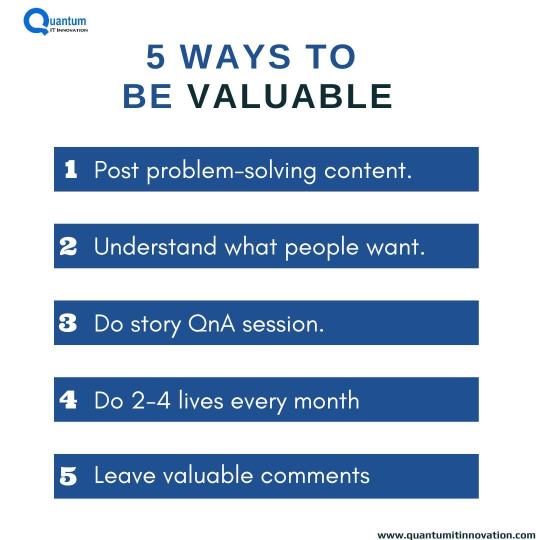
Ruby on Rails (RoR) remains a preferred framework for developing dynamic and robust websites, powering countless applications across various industries. However, building a Ruby on Rails website is only the beginning of the journey. To ensure its longevity, security, and optimal performance, regular maintenance and updates are imperative. In this article, we delve into the best practices for maintaining and updating Ruby on Rails websites, emphasizing the importance of partnering with a reputable ruby on rails development company usa to achieve sustainable success.
Understanding the Importance of Maintenance
Maintaining a Ruby on Rails website goes beyond fixing bugs and adding new features. It involves ongoing efforts to ensure the website remains secure, efficient, and aligned with evolving industry standards and user expectations. By prioritizing maintenance, businesses can safeguard their investment, enhance user experience, and stay ahead of potential issues that may arise over time.
Best Practices for Maintaining Ruby on Rails Websites
Regular Software Updates: Stay current with the latest versions of Ruby on Rails, as well as associated gems and dependencies. Regular updates not only introduce new features and performance improvements but also address security vulnerabilities and bug fixes identified in earlier versions.
Security Audits and Vulnerability Scans: Conduct periodic security audits and vulnerability scans to identify potential security threats and weaknesses in the website's codebase. Address any vulnerabilities promptly and implement robust security measures to protect against common attack vectors, such as SQL injection, cross-site scripting (XSS), and CSRF attacks.
Database Optimization: Optimize database performance by implementing indexing, query optimization techniques, and database caching strategies. Regularly monitor database performance metrics and identify opportunities for optimization to improve overall website speed and responsiveness.
Backup and Disaster Recovery: Implement regular backup and disaster recovery procedures to protect against data loss and system failures. Maintain redundant backups of critical data and implement automated backup schedules to ensure data integrity and availability in the event of an unforeseen disaster or system failure.
Code Refactoring and Cleanup: Periodically review and refactor codebase to remove deprecated methods, optimize performance, and enhance code readability and maintainability. Adopt coding standards and best practices to ensure consistency and coherence across the codebase, making it easier to maintain and update in the long run.
Strategies for Updating Ruby on Rails Websites
Staging Environment Testing: Before deploying updates to the production environment, conduct thorough testing in a staging environment to identify and address any compatibility issues, bugs, or regressions. Test functionality, performance, and compatibility across different browsers and devices to ensure a seamless user experience post-update.
Version Control and Deployment Automation: Utilize version control systems such as Git and implement deployment automation tools like Capistrano or DeployHQ to streamline the update process and minimize human error. Maintain separate branches for development, staging, and production environments to facilitate code review, collaboration, and version tracking.
Rollback Procedures: Establish rollback procedures and contingency plans in case of unforeseen issues or errors during the update process. Maintain backups of previous versions and implement rollback mechanisms to quickly revert to a stable state in the event of a failed deployment or critical issue post-update.
User Communication and Feedback: Keep users informed about upcoming updates, maintenance schedules, and changes to the website's functionality or user interface. Solicit feedback from users following updates to identify any usability issues, performance concerns, or feature requests, and incorporate user feedback into future updates and iterations.
Partnering with a Ruby on Rails Development Company in the USA
Navigating the complexities of maintaining and updating Ruby on Rails websites requires expertise, experience, and technical proficiency. Partnering with a reputable Ruby on Rails development company in the USA can provide businesses with access to seasoned professionals, industry best practices, and cutting-edge technologies that drive sustainable success.
By collaborating with a trusted ruby on rails web development company usa businesses can benefit from comprehensive maintenance and support services tailored to their specific needs and objectives. From routine updates and security patches to performance optimization and scalability enhancements, a dedicated development partner can help businesses maximize the value of their Ruby on Rails website while mitigating risks and minimizing downtime.
Conclusion
In conclusion, maintaining and updating Ruby on Rails websites is essential for ensuring long-term viability, security, and performance. By adhering to best practices for maintenance and updates, businesses can proactively address potential issues, enhance user experience, and stay ahead of the curve in an ever-evolving digital landscape. By partnering with a reputable ruby on rails web development services usa, businesses can leverage expertise, innovation, and collaboration to achieve sustainable success and unlock the full potential of their Ruby on Rails websites in today's competitive market.
#ruby on rails development company usa#ruby on rails web development company usa#ruby on rails web development services usa
0 notes
Text
A Comprehensive Guide to Unit Testing in Software Development
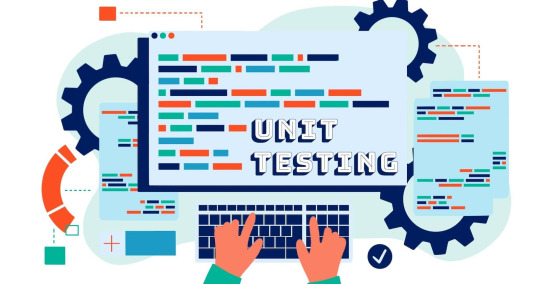
Introduction:
Unit testing is a technique of testing that emphasizes testing a particular piece of code. Unit testing is mainly done to test the functionality of a block of code i.e to check whether the code does what you expect it to do. But does that mean we have to test every functionality individually? An application has numerous functions, wouldn't writing test cases for each of them increase the development time? Let's check this out in detail.
What exactly is a "unit" in unit testing?
A unit can either be a class or an interface, functionality or even an entire package/module.
It is the smallest piece of code that can be tested in isolation.
The word “isolation” has been emphasized here since a test case is not considered to be a unit test if the test cases run parallel to other test cases.
The idea behind unit testing:
The primary goal behind unit testing is to isolate a chunk of your code and then verify if that piece of code works as it is expected to work or not.
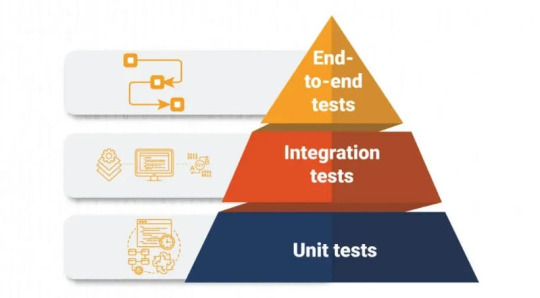
Unit testing is the first level of testing and is done mostly by the developers who have developed the application since developers are the ones who have first-hand knowledge about the logical execution of a piece of code.
For example, let us consider that we have an eCommerce application with functionalities like product filtering, payment gateway, login logout system etc. Therefore, to test let’s say the product filtering function, you have to make sure that the function gives you the same set of output based on a given range of colors, brands and prices. This can be done by writing another function that calls the product filtering function with different input parameters and would then check whether the out given by the function and the output that we expect it to give are the same or not.

The developers mostly use unit testing as a means of validating the functionality or the logical execution of the code. Since there can be several functionalities in your application, you might need to create several unit test cases to cover the execution of each function. Therefore the developers need to keep in mind that the unit test does not slow down the performance or increase the development time of the code. It is due to this reason that a test case is not considered to be a unit test if it talks to the database or if it is dependent on the file system since this would slow down the performance.
Unit testing focuses only on a particular piece of code that should be tested in isolation. It is due to this reason, that a unit test case has a very precise extent of assessment. Unit test cases target a single piece of code, and in case the test fails, we know exactly where the fault is coming from. This in turn helps in looking for bugs in the application and fixing them during the early stage of its development.
Pros of unit testing:
Through unit testing, developers can detect and fix the bugs during the early stages of development which increases the efficiency of your code. Refactoring of code becomes much easier if you have unit tests in place.
Detection of errors in the early stages helps in eliminating the bugs which could lead to major issues in the future stages of development. This as a matter of fact, also saves a developer's time.
Unit testing also enhances the readability and understandability of code by the developers.
Cons of unit testing:
Writing unit tests for each functionality can be cumbersome and time-consuming.
Even though unit testing is done for chunks of code in isolation, not all errors are detected. Some errors might occur when the different modules interface with each other. These errors are mostly detected during the integration testing phase.
Since unit testing tests the logical implementation of a code, it cannot test the application for its non-functional characteristics such as usability, scalability and performance
Techniques of unit testing:

Unit testing techniques are of 3 types.
White box testing: Also known as glass box testing, transparent testing or structural testing. This approach requires an in-depth knowledge of the internal structure of a function. Thus this technique allows the testers to validate the logical aspect of a function i.e to test the behavior of a function.
Black box testing: In this approach, test cases are designed without any knowledge of the design or internal structure of the program. The test cases are designed entirely by analyzing the input/output behavior of the function. This approach is also known as function testing since the test cases are designed only based on the functional specification of the software. Test cases are designed entirely from the user’s point of view.
Gray box testing: Also known as semi-transparent testing, this approach is a mixture of both black box testing and white box testing (hence the name gray box testing). Here, the testers know the internal structure and its working. However, this knowledge is quite limited.
Myths of unit testing:
“Unit testing increases the burden on a project”
While a part of it might be true, Unit testing your product would save your product from having major bugs and issues in the future development stages of your product. Since unit testing increases code reusability, it is in turn saving your development time and effort.
“It’s a simple piece of code, therefore it does not need testing”
Again, a part of it might be true. However, you never know where the error may come from in the future. The code might seem simple to you, until and unless something goes wrong. Defining test cases for even the simplest piece of code would add stability and security to your product.
Conclusion:
Unit testing is said to be the heart of the development lifecycle. Help you in detecting bugs in the early stages of development and save time, effort and development cost. Therefore, unit testing is a crucial part of any project. There are other levels of testing as well (Integration testing, end-to-end testing etc.), however, unit testing is the core of all testing levels.
0 notes
Text
Driving Efficiency with Generative AI: Reducing Automation Efforts in Testing

Today is just the beginning of Generative AI and its countless benefits. Generative AI applications such as ChatGPT, GitHub Copilot, DeepArt, and others have taken the world by storm by unleashing a wave of innovation, creativity, and productivity. We are now able to do tasks that were previously unimaginable.
Generative AI – Catalyst or Replacement?
Generative AI can mimic human capabilities to an astonishing level, raising fears about AI replacing humans. However, it’s important to understand that Generative AI will only empower humans and not replace them.

So what are the potential business benefits?
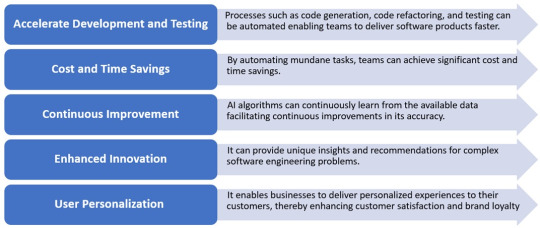
Generative AI Use Cases
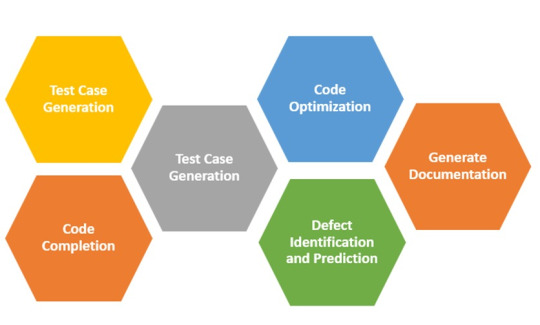
Test Case Generation
Generative AI can help in generating comprehensive test cases by analyzing the requirements and existing code of the application. You can also use it to cover positive and negative test cases and edge cases.
For the banking application example, it can generate test cases to cover various scenarios such as creating new accounts, making fund transfers between different account types, testing different transaction limits, and verifying balance.
Code Completion
Imagine the amount of time developers can save if they could get recommendations and code snippets to expedite the coding process. Generative AI understands the semantics and structure of the existing code and thus provides accurate suggestions.
Examples include CodeAI and GitHub’s CoPilot. They use contextual understanding, trained models, and code repositories to generate code snippets, accelerating the coding process and aiding the developers in reducing human errors.
According to Mckinsey research, technology companies are already using Generative AI such as Replit which is being used by more than 20 million coders today.
Test Data Generation
Thorough application testing requires a diverse range of test data to simulate different scenarios and ensure overall test coverage. Generative AI can help create realistic test data.
For the banking application scenario, it can generate sample customer account details, names, addresses, and other required test data.
Code Optimization
The development teams work on applications that involve complex code and algorithms. Generative AI algorithms can analyze code and identify any performance bottlenecks. They can also propose code refactoring suggestions to enhance readability.
For example, it can identify inefficient algorithms or resources used in any feature that takes up the maximum CPU usage, and suggest alternative implementations that improve the execution speed. This simplification reduces the complexity of the code, making it easier to test and maintain.
Defect Identification and Prediction
With Generative AI, it’s easier to identify possible coding errors or any deviations from the coding standards. By leveraging AI and machine learning techniques, it can learn from previous defects, detect patterns and also predict defects.
For example, Webomates’ AI Defect Predictor helps the development and QA teams that use CI/CD service to reduce their triage time. This proactive approach enables the development and testing teams to correct their code and reduces the overall effort required in automation testing.
Generate Documentation
By extracting data from code, test cases, and other resources, generative AI can automate the documentation process. Developers and testers don’t have to spend their time manually updating and creating documentation, which saves them time and effort.
Accenture is testing the use of OpenAI LLMs to automatically generate documentation – for example, SAP configuration rationale and functional or technical requirements.
Limitations of Generative AI Capabilities
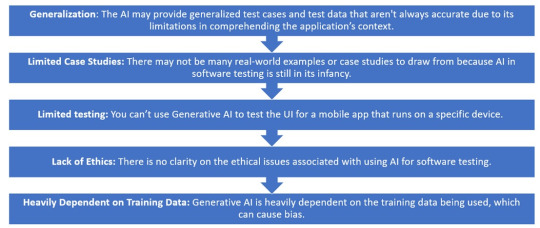
How Can Webomates Help?
Generative AI is here. And as it keeps evolving, it will unlock new possibilities for improved efficiency and innovations. Meanwhile, we can leverage it to transform our application testing and automation efforts.
Webomates understands that AI-based software testing speeds up product releases and generates the promised business value. It’s an industry- and tool-agnostic solution to optimize testing in various scenarios.
Schedule a demo to discover the full potential of our AI-driven software testing solutions that can boost your business outcomes, increase productivity, and accelerate product releases. You can also reach out to us at [email protected]
1 note
·
View note
Text
[ad_1] Title: Achieving Maintainable Code: The Key to Long-term Success in Software Development Introduction: In the rapidly evolving field of software development, writing code that is not only functional but also maintainable is of utmost importance. Maintainable code ensures that software systems can adapt to changing requirements over time, leading to improved efficiency, cost-effectiveness, and overall user satisfaction. In this comprehensive article, we will explore the principles and best practices for creating maintainable code, along with actionable tips and real-world examples. Table of Contents: I. Understanding Maintainable Code A. Definition and Importance B. Benefits of Maintainable Code II. Factors Influencing Perplexity and Burstiness in Code A. Perplexity: Measuring Complexity B. Burstiness: Embracing Variation and Sentence Structure III. Writing Maintainable Code: Best Practices A. Consistent Code Formatting B. Adopting Standard Naming Conventions C. Modularization and Code Reusability D. Effective Documentation E. Proper Error Handling and Exception Management F. Test-Driven Development (TDD) and Automated Testing G. Version Control Systems and Code Review H. Refactoring Techniques for Code Improvement I. Optimization and Performance Considerations IV. Strategies for Enforcing Maintainability in a Team Environment A. Communication and Collaboration B. Code Reviews and Pair Programming C. Continuous Integration and Deployment V. Tools and Technologies for Enhancing Maintainability A. Integrated Development Environments (IDEs) B. Code Analysis and Linting Tools C. Documentation Generators D. Automated Build and Deployment Systems E. Version Control Systems and Git Workflows VI. Frequently Asked Questions (FAQs) A. How does maintainable code impact software scalability? B. Can I achieve maintainable code without compromising performance? C. Is maintainable code more time-consuming to write initially? D. What are the common challenges in maintaining legacy codebases? E. How can code reviews contribute to maintainability? F. Are coding standards essential for maintaining code quality? VII. Conclusion I. Understanding Maintainable Code In this section, we will grasp the essence of maintainable code, its definition, and its significance in the software development lifecycle. By emphasizing the benefits that it brings to developers, end-users, and organizations, readers will gain a profound understanding of its role in successful software projects. II. Factors Influencing Perplexity and Burstiness in Code Here, we will delve into the concept of perplexity and burstiness in code. We will explore how these factors can improve code quality and readability, using both human and AI perspectives. By harnessing an appropriate balance between the two, developers can create code that is both complex and varied, paving the way for maintainability. III. Writing Maintainable Code: Best Practices This section will unveil a range of practical tips and best practices for writing maintainable code. Starting from consistent code formatting to techniques for refactoring and optimization, we will equip our readers with actionable advice that they can implement immediately in their projects. IV. Strategies for Enforcing Maintainability in a Team Environment Maintaining code quality is not limited to individual developers alone. Effective teamwork and collaboration play a vital role in achieving maintainable code. In this section, we will explore strategies to promote maintainability within a team, such as fostering open communication, enabling code reviews, and implementing continuous integration and deployment processes. V. Tools and Technologies for Enhancing Maintainability To facilitate the creation of maintainable code, developers can rely on various tools and technologies. This section will introduce readers to a selection of widely-used tools,
IDEs, code analysis utilities, and version control systems that contribute significantly to code maintainability and overall development efficiency. VI. Frequently Asked Questions (FAQs) To address common queries and concerns related to maintainable code, we will compile a list of frequently asked questions and provide detailed answers. By clearing any doubts readers may have, we can instill confidence in the value and feasibility of creating maintainable code. VII. Conclusion In conclusion, this comprehensive article has shed light on the pivotal role of maintainable code in software development. By implementing the best practices and strategies outlined, developers can ensure better software quality, longevity, and adaptability in a rapidly evolving tech landscape. Embracing maintainable code is not only a professional responsibility but also a competitive advantage in delivering software solutions that stand the test of time. By incorporating relevant HTML headings, subheadings, and an FAQ section that addresses common concerns, this article brings together both the technical and practical aspects of maintainable code, ensuring an informative and engaging resource for developers and software enthusiasts alike. So, get ready to embark on the journey to writing high-quality, maintainable code that sets you apart in the world of software development. [ad_2] #Maintainable #Code
0 notes
Text
Code Refactoring Techniques : Enhancing Readability and Performance

Welcome to the world of code refactoring, where readability and performance reign supreme! In the fast-paced realm of programming, it’s essential for developers to constantly upgrade their codebase. But fear not! We’ve got your back with a treasure trove of tried-and-true techniques that will take your software craftsmanship to new heights. Brace yourself as we embark on an exhilarating journey filled with practical tips and mind-blowing insights into enhancing both readability and performance. Get ready to refactor like a pro and watch your code transform from good to exceptional. Let’s dive in! Visit More - https://www.gmatechnology.com/code-refactoring-techniques-enhancing-readability-and-performance/
#Code Refactoring Techniques : Enhancing Readability and Performance#web development#web design#magento development#best web development company in united states#logo design company#digital marketing company in usa#web designing company#website landing page design#asp.net web and application development#web development company
1 note
·
View note
Text
Code Refactoring Techniques : Enhancing Readability and Performance

Welcome to the world of code refactoring, where readability and performance reign supreme! In the fast-paced realm of programming, it’s essential for developers to constantly upgrade their codebase. But fear not! We’ve got your back with a treasure trove of tried-and-true techniques that will take your software craftsmanship to new heights. Brace yourself as we embark on an exhilarating journey filled with practical tips and mind-blowing insights into enhancing both readability and performance. Get ready to refactor like a pro and watch your code transform from good to exceptional. Let’s dive in!
What Is Refactoring?
Refactoring code means making changes to the structure or organization of your code without changing its behavior. These changes can make your code more readable, easier to maintain, and more efficient.
There are many different refactoring techniques, but some common ones include:
Extracting methods: This involves taking a section of code and turning it into a separate method. This can make your code more readable and easier to reuse.
Renaming variables: This helps make your code more understandable by giving variables names that describe their purpose.
Extracting classes: This helps keep your code organized by moving related functionality into its own class.
In general, refactoring is about making small, incremental changes to your code that improve its overall quality. By regularly refactoring your code, you can make it easier to work with and less likely to contain errors.
Why Should You Refactor Your Code?
When it comes to code, there is always room for improvement. No matter how proud you are of your code, chances are there are ways to make it better. That’s where code refactoring comes in.
Refactoring is the process of improving the design of existing code without changing its functionality. It’s a way to make your code simpler, cleaner, and more robust. And, as an added bonus, refactoring can also improve performance.
There are many reasons why you should refactor your code. Here are just a few:
To improve readability and maintainability
Well-designed code is easy to read and understand. This makes it easier to work with, debug, and extend. By contrast, poorly designed code can be very difficult to work with – even for the original author! Refactoring can help improve the readability of your code so that it is easier to maintain in the long run.
To avoid technical debt
Technical debt is the accumulation of small design decisions that make your code harder to work with over time. If left unaddressed, technical debt will eventually lead to problems such as code rot or server outages. Refactoring can help you avoid these problems by keeping your code clean and well-designed from the start.
To improve performance
Poorly designed code can be slow and inefficient. By contrast, well-designed code tends to be faster and more efficient. Refactoring can help you make sure that your code is optimized for performance, so that it runs faster and more reliably.
Ultimately, refactoring your code is an investment. It may take time to clean up your codebase, but the benefits are worth the effort. So if you want to improve the quality of your code, consider taking some time to refactor it!
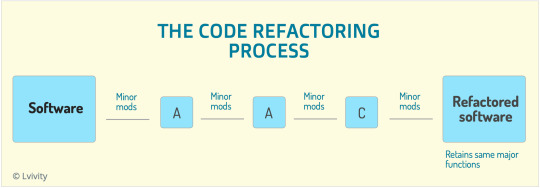
Different Types Of Refactoring Techniques
There are dozens of different code refactoring techniques that can be used to enhance the readability and performance of your code. However, not all of these techniques are equally effective or applicable in every situation. Here is a brief overview of some of the most popular code refactoring techniques:
Extract Method: This technique is used to extract a section of code into a separate method. This can make your code more readable and easier to maintain.
Rename Variable: This technique is used to rename variables for clarity. This can make your code more readable and easier to understand.
Replace Conditional with Polymorphism: This technique is used to replace complex conditional statements with polymorphism. This can make your code more reliable and easier to modify.
Inline Method: This technique is used to inline a method call into the caller method body. This can improve performance by avoiding unnecessary method calls.
Replace Magic Numbers with Constants: This technique is used to replace magic numbers (literal values that have no specific meaning) with constants (named values that have a specific meaning). This can improve the readability and maintainability of your code .
Introduce Parameter Object: This technique is used to introduce a parameter object to replace multiple parameters in a method. This can improve the readability and maintainability of your code.
Extract Interface: This technique is used to extract an interface from a class or group of classes. This can make your code more modular and easier to test.
Breaking Down A Long Method Into Shorter Ones
It is always a good practice to break down a long method into shorter ones. This not only enhances the readability of the code but also improves performance. There are various techniques that can be used to achieve this.
One common technique is to use the extract method refactoring. This entails taking a section of code from a long method and extracting it into a new method. The extracted code should be self-contained and serve a specific purpose. It should also be easy to understand and test.
Another useful technique is known as the split phase refactoring. This involves breaking up a long method into two or more shorter methods. The first method would contain the initial processing, while the second method would handle the remaining tasks. This division of labor can make the code more readable and easier to maintain.
It is sometimes possible to replace a long method with several smaller ones that each perform a specific task. This approach can improve readability by making it easier to see the overall structure of the code. It can also lead to better performance, since each small method can be optimized independently.
Removing Repetitive Code
When it comes to code refactoring, one of the most important things to keep in mind is removing repetitive code. Repeating code not only makes your code more difficult to read, but it can also lead to errors and decreased performance.
There are a few different ways that you can remove repetitive code:
Combine similar code blocks: If you have two or more code blocks that are doing similar things, you can combine them into one block of code. This will simplify your code and make it easier to read.
Extract common functionality into functions or methods: If you have repetitious code that is used in multiple places, you can extract it into a separate function or method. This way, you can call the function or method whenever you need the functionality, instead of having to copy and paste the code each time.
Use loops: Loops are a great way to avoid repetition in your code. If you find yourself writing the same piece of code multiple times, try using a loop instead. This will enable you to execute the code once for each item in a given list or collection.
Simplify conditional statements: If you have complex conditional statements, such as nested if statements, try simplifying them. You can do this by extracting parts of the condition into separate variables or methods. This will make your conditional statements easier to read and understand.
Remove unused variables and dead code: Unused variables and dead code (code that is never called) can make your code harder to read and maintain. Always make sure that your variables are only declared when they are needed and that any dead code is removed from the project.
Enhancing The Performance And Readability With Other Techniques
There are other techniques that can be used to improve the readability and performance of your code. One such technique is to use comments. Comments can help to explain what your code is doing and make it more understandable. Another technique is to use white space effectively. Indenting your code and using blank lines can help to make it more readable. You can also use shorter variable and function names to improve readability. Additionally, you can use certain design patterns that promote code performance. For example, using the single responsibility principle (SRP) can help to split up long functions into smaller ones and make your code more efficient. Additionally, caching data and using lazy loading can help to improve execution times when dealing with large data sets. Finally, use library functions whenever possible instead of writing your own codes so that you can benefit from other developers’ experience.
There are several other techniques that can be used to enhance the readability and performance of code. One such technique is ‘code comments’. Comments can be used to explain the purpose of a particular section of code, or to provide information about how a particular function works.
Another technique that can be used to improve performance is ‘code optimization’. This involves making changes to the code so that it runs faster and uses less memory. Code optimization is a technical process that should only be carried out by experienced developers.
Another way to improve the readability and performance of code is to use ‘coding conventions’. Coding conventions are a set of guidelines that specify how code should be written. For example, they may dictate how variables should be named, or how functions should be organized. By following coding conventions, developers can make their code more consistent and easier to read.
Coding Guidelines For Refactoring
When refactoring code, it is important to adhere to coding guidelines in order to improve the readability and performance of the code. Some tips for doing this include:
-Using descriptive variable and function names – Organizing code into logical blocks – Keeping code simple and concise – eliminating redundancy – following standard coding conventions
Conclusion
Code refactoring techniques can be incredibly helpful when it comes to improving the readability and performance of your codebase. By testing which refactoring methods work best for you, you can optimize your code for better overall performance. Reorganizing functions, using naming conventions, creating templates and reducing duplication are just a few of the ways that developers can make their codes more streamlined and efficient. Ultimately, investing in this type of quality assurance will help ensure successful software development projects going forward.
#Code Refactoring Techniques : Enhancing Readability and Performance#web development#best web development company in united states#magento development#digital marketing company in usa#logo design company#asp.net web and application development#website landing page design#web design#web development company#web designing company
0 notes
Text
Achieving Excellence in Code: Strategies for Clean and Maintainable Software
In today’s fast-paced web development landscape, where the pressure to deliver rapidly is immense, the importance of code quality can often be overlooked. At 5ine, a leading web development company in Bangalore, we see code quality not as an afterthought but as a fundamental pillar of our work. It’s what drives our success and ensures our clients receive not just functional but exceptional digital solutions. Here’s why code quality matters and how we at 5ine consistently achieve it through meticulous practices.
Why Code Quality Matters
The quality of code isn’t just about aesthetics—it’s about building a robust foundation that impacts every aspect of a web development project:
Maintainability: High-quality, well-structured code is easier to modify, update, and extend. This is crucial as projects grow and evolve over time, making future enhancements smoother and less costly.
Reliability: Code quality directly affects the stability of an application. Clean code is less prone to bugs, reducing downtime and ensuring a more reliable user experience.
Scalability: As business needs expand, so too must the application. Clean, organized code facilitates easier scaling, allowing for new features and capabilities to be added without major overhauls.
Team Collaboration: Consistent coding standards and practices enhance team collaboration. When everyone adheres to the same principles, it reduces friction and improves efficiency, enabling teams to work seamlessly together.
5ine’s Proven Techniques for Clean and Maintainable Code
At 5ine, we employ a range of best practices that ensure our code is of the highest quality:
Strict Adherence to Coding Standards: We follow industry-standard coding conventions (such as PSR for PHP and PEP8 for Python), which promote consistency and clarity across the codebase. This not only improves readability but also makes onboarding new developers easier.
Comprehensive Code Reviews: Every piece of code we write undergoes thorough peer reviews. This process is critical for identifying potential issues early, enforcing best practices, and fostering a culture of continuous learning and collaboration within the team.
Rigorous Automated Testing: We place a strong emphasis on automated testing, including unit, integration, and end-to-end tests. These tests catch issues early in the development cycle, ensuring that new code doesn’t introduce bugs or regressions.
Continuous Refactoring: Refactoring is an ongoing process at 5ine. We regularly revisit our code to remove redundancies, enhance readability, and improve performance, ensuring that the codebase remains efficient and maintainable over time.
Comprehensive Documentation: Proper documentation is key to understanding and maintaining the codebase. We ensure that every component of our code—APIs, libraries, and internal logic—is thoroughly documented, making it easier for team members and stakeholders to navigate and understand.
Elevating Code Quality: 5ine’s Approach
Code quality at 5ine is more than just a practice; it’s ingrained in our DNA. Here’s how we elevate our work:
Continuous Learning and Development: We invest heavily in the professional growth of our developers. Through regular training and access to the latest tools and resources, our team stays ahead of industry trends and best practices.
Robust Quality Assurance: Our QA processes are designed to be comprehensive and rigorous. Every piece of code is tested against stringent criteria to ensure it meets our high standards before it’s delivered to the client.
Collaborative Client Involvement: We believe in close collaboration with our clients throughout the development process. By engaging clients early and often, we ensure that their feedback is incorporated, leading to a final product that not only meets but exceeds expectations in terms of both functionality and quality.
5ine’s Holistic Web Development Approach
Beyond code quality, 5ine is committed to delivering exceptional web development services that cater to the unique needs of each client:
Customized Solutions: We specialize in developing tailor-made solutions that address the specific challenges and goals of our clients, ensuring that every project is a perfect fit.
State-of-the-Art Technologies: We leverage the latest technologies and frameworks, ensuring that our web applications are not only modern but also highly efficient and scalable.
User-Centered Design: Our design philosophy prioritizes the end-user experience, creating intuitive, engaging, and accessible interfaces that drive user satisfaction and loyalty.
Conclusion
At 5ine, code quality is not just about writing clean code—it’s about laying a solid foundation for long-term success. By prioritizing code quality, we reduce maintenance costs, enhance reliability, and accelerate development timelines. Our commitment to rigorous standards, continuous improvement, and close client collaboration ensures that the solutions we deliver are not only functional but also robust, scalable, and future-proof.
If you’re looking for a web development partner who values excellence in code quality and delivers outstanding, tailor-made solutions, 5ine is your ideal choice. Contact us today to discover how we can transform your ideas into exceptional digital experiences.
#web development services in Bangalore#best web development company in bangalore#website development company bangalore
0 notes
Text
[ad_1] Code Refactoring 101: Expert Coding Tips & Tricks for Clean Code HTML Headings: 1. Introduction: Understanding the Significance of Code Refactoring 2. The Basics: What is Code Refactoring? 3. Why Code Refactoring is Essential for Clean Code 4. Best Practices for Code Refactoring a. Identify Smells: Common Indicators for Refactoring b. Refactoring Techniques and Tools c. Importance of Unit Tests during Code Refactoring 5. Code Refactoring Patterns and Strategies a. Extract Method: Simplify Complex Code Blocks b. Rename Variables: Enhancing Code Readability c. Remove Duplication: DRY Principle in Action d. Reorganize Conditionals: Making Logic Clearer e. Replace Conditional with Polymorphism: Object-Oriented Refactoring f. Split Long Methods: Enhancing Maintainability g. Inline Method: Reducing Unnecessary Abstractions 6. Advanced Refactoring Techniques a. Extract Class: Isolating Responsibility b. Introduce Design Patterns: Optimizing Code Structure c. Functional Refactoring: Leveraging Functional Programming d. Database Schema Refactoring: Database Optimization e. Refactoring Legacy Code: Breathing New Life into Older Projects f. Refactoring in Agile Development: Continuous Improvement 7. Benefits and Challenges of Code Refactoring a. Benefits of Code Refactoring: Enhancing Readability and Maintainability b. Overcoming Challenges: Time and Resource Management 8. Code Refactoring Tools and Resources a. Popular Code Editors and Plugins for Refactoring b. Online Resources for Learning and Practicing Refactoring c. Code Review Practices for Effective Refactoring 9. FAQs: Answers to Commonly Asked Questions a. What is the difference between code optimization and code refactoring? b. Can code refactoring introduce new bugs? c. How often should code refactoring be performed? d. How to measure the success of code refactoring? e. Is code refactoring applicable to all programming languages? 10. Conclusion: Embracing Code Refactoring for Cleaner and Maintainable Code Subheadings within the sections should be added based on the content structure and provided information. FAQs Section: Q: What is the difference between code optimization and code refactoring? A: Code optimization focuses on improving code performance, often by making changes at a lower level, such as improving algorithms or reducing resource usage. Code refactoring, on the other hand, aims to improve the internal structure and design of the code without altering its functionality. It primarily focuses on enhancing readability, maintainability, and extensibility. Q: Can code refactoring introduce new bugs? A: While code refactoring aims to improve code quality, there is a possibility of introducing new bugs if not done carefully. That's why it is crucial to have a solid suite of unit tests before starting any refactoring process. Comprehensive testing, combined with disciplined refactoring practices, minimizes the risk of introducing new bugs. Q: How often should code refactoring be performed? A: Code refactoring should be performed regularly throughout the development process, ideally in small increments during each development cycle. The frequency may vary based on the project's complexity, size, and team dynamics. Refactoring should be an ongoing practice to maintain code quality and prevent it from becoming a burdensome and error-prone legacy codebase. Q: How to measure the success of code refactoring? A: The success of code refactoring can be measured using various metrics, such as increased code readability, reduced code duplication, improved performance, and ease of adding new features. It is essential to establish key indicators and set specific goals before the refactoring process begins to assess its impact effectively. Q: Is code refactoring applicable to all programming languages? A: Yes, code refactoring is applicable to all programming languages and paradigms. While
some refactoring techniques might be more relevant in certain languages, the underlying principles remain the same. Whether it's object-oriented, functional, or procedural programming, maintaining clean and maintainable code is a universal practice. Incorporating the main keyword, "Code Refactoring," throughout the article will help improve its search engine ranking and visibility. Keep in mind to maintain a natural and contextual inclusion of the keyword to avoid overly repetitive usage. [ad_2] #Code #Refactoring #Expert #Coding #Tips #Tricks #Clean
0 notes
Text
Code Refactoring Techniques : Enhancing Readability and Performance
Welcome to the world of code refactoring, where readability and performance reign supreme! In the fast-paced realm of programming, it’s essential for developers to constantly upgrade their codebase. But fear not! We’ve got your back with a treasure trove of tried-and-true techniques that will take your software craftsmanship to new heights. Brace yourself as we embark on an exhilarating journey filled with practical tips and mind-blowing insights into enhancing both readability and performance. Get ready to refactor like a pro and watch your code transform from good to exceptional. Let’s dive in! Visit More - https://www.gmatechnology.com/code-refactoring-techniques-enhancing-readability-and-performance/

#Code Refactoring Techniques : Enhancing Readability and Performance#web development#web design#magento development#best web development company in united states#website landing page design#digital marketing company in usa#web designing company#logo design company#web development company#asp.net web and application development
0 notes